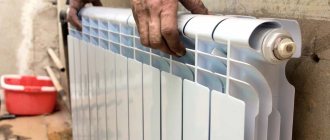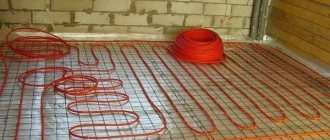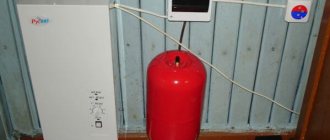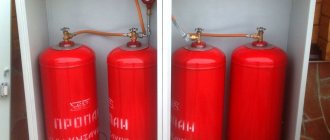Having decided to install a heated floor in an apartment or house, and having given preference to an electric device rather than a water one, you need to understand that in addition to installation costs, you will have constant costs for paying for electricity. Therefore, you need to calculate in advance how much electricity the warm floor will consume.
The article presents the characteristics of all models of electric floors, their advantages and disadvantages, as well as a comparative analysis of power consumption by each type.
In addition, we have tried to collect here all the advice from professionals that will help reduce the costs of operating these systems and save the family budget.
Types of electric heated floors
Today there is a huge range of electric flooring systems on the market. All of them are divided into several types.
Below we will analyze in detail the technical characteristics of each type, calculate the electricity consumption depending on the type of room per 1 m2 per hour, per month. We will also find out how the topcoat affects energy consumption.
Electrical cable
An electrical cable is a wire that is laid randomly, but more often in a “snail” or “snake” pattern. The structure is filled with a concrete screed on top, which reduces the height of the room by an average of 5 cm. The specific power of such a cable is from 0.01 to 0.06 kW/m2, its choice depends on the frequency of turns.
The energy intensity of one meter of cable ranges from 10 to 60 W. To cover 1 m2 of surface, about 5 meters of wire are required, thus heating on average requires 120 - 200 W of electricity.
Thermomat
Heating mats are a structure made of cable, which is laid according to a certain pattern on a special grid. It is often mounted under a screed and is perfect for installation in rooms with high humidity.
This model is intended for rooms with low ceilings, since the thickness of the “pie” is only 3 cm. The power of the mat is up to 0.2 kW/m2.
The average consumption per square meter of a heating mat is 120 - 200 W.
Infrared film
Infrared heated floor is a thin polymer film coated with a carbon layer. When heated, carbon emits heat.
IR film does not affect the height of ceilings. On average, about 150 - 400 W of electricity is wound to warm up 1 m2 of film.
Rod floor
Rod floor - refers to the infrared type, but instead of carbon plates it contains rods. Its energy consumption is 120 - 200 W per square meter.
Power consumption of heated floors
As mentioned above, the following types of heated floors are currently used: film, cable and using mats. Film heated floors are most often used when laid under laminate and linoleum; cables and mats are more common when used under cement screed or ceramic tiles. Although this division is very arbitrary, an infrared diaper floor can be used with equal success under both laminate and ceramic tiles. Each of the heating elements listed above has a certain set of characteristics: geometric parameters, power consumption, operating temperature.
In this case, we are interested specifically in the issue of electricity consumption, so let’s look at how much electricity a particular heating element consumes:
- infrared film - one of the most popular design solutions for heated floors today consumes electricity from 150 to 400 watts per square meter of coverage;
- thermomats - from 120 to 200 watts per square meter of coverage;
- heating cable - from 10 to 60 watts per square meter.
On average, we can say that the electricity consumption of underfloor heating is limited to the range of 120-200 watts per square meter. This indicator is quite economical, which allows you to use heated floors as the main and auxiliary heating source.
Calculation of electricity costs by type
To determine how much current an electric heated floor consumes, we consider a number of the following factors: heat loss, thickness of the base and the degree of thermal insulation of the room.
The formula will help you calculate the amount of electricity consumed:
W=S*P*0.4, where
- S—area in m2;
- P—power;
- 0.4 - coefficient of heated usable area.
Electrical cable and mats
To determine the amount of electricity consumed and the cost of paying for it when operating a cable system, it is necessary to take into account a number of points:
- The size of the heated area is the free part of the room without furniture. Usually it is 12 - 15 sq. m., this is where the cable or mats will be laid.
- To heat 15 m² of floor, on average, a wire is required, the total power of which is 2100 Wh. More often, consumers purchase foreign products designed for a voltage of 230W. In our conditions, such a cable cannot function at full capacity. It is capable of consuming no more than 1930 W.
- 1930 W - the power consumed by a warm cable floor at maximum load. In this case, the heating temperature can reach +45°C. Temperatures up to + 23°C are considered comfortable. A floor in such conditions can consume about 965 watts.
- According to calculations, to maintain a comfortable atmosphere, it is necessary to heat the cable for 20 minutes every hour. As a result, the power consumption for heating 1 m2 of floor is no more than 322 W/hour.
You can pay less for the energy consumed by cable heated electric floors if you use a two-tariff meter.
In addition, when using a cable, to determine the amount of electricity consumed, you need to calculate its length. This is easy to do using the formula:
L=l/a
Where:
- l - wire length:
- a is the pitch between the cable loops.
By multiplying this value by the power of the wire (120-200 Watt), you will get the amount of electricity consumed by the heated floor per 1 m2.
Infrared heated floor
If infrared heated floors are used, then their energy consumption, as with the operation of any heating system, is affected by the degree of preparation of the room. In addition, the power of the film is considered an important factor. When using the device as the main heating - 220 W/m2, if additional - 150 W/m2.
For your information! Film 220 W per hour needs to be heated for 5 - 7 minutes, and 150 W - 12 minutes. At the same time, they will consume electricity on average the same.
Let’s consider how much energy warm film floors consume per month using the example of a room of 50 square meters, with a film power of 150 W. For this:
W=50*150*0.4=3000 W or 3 kilowatts in 60 minutes.
To calculate monthly consumption, you need to:
3000 / 60 minutes x 5 minutes (running time per hour) x 12 hours per day x 30 days per month = 90,000 W/month or 90 kW
The resulting figure is multiplied by the tariff of your region - how much you will spend on paying for electricity in money. Naturally, this figure is approximate, and when using a “day - night” meter.
With proper calculation and planning, costs can be significantly reduced.
How to calculate future energy costs
It is not difficult to determine the estimated monthly electricity consumption. You can do this yourself using the formula:
W=0.4xSхP
where P is power consumption, W/m2;
S – area of the heated room, m2;
0.4 – coefficient taking into account the usable area. A little clarification is in order here. Laying heated floors over all surfaces of the room is impractical. Firstly , according to the installation technology, you need to make a retreat from the wall of about 10-20 cm. Secondly , if there are other powerful heat sources in the room, for example, a fireplace and stove, then you need to retreat at least a meter from them. Thirdly , laying heated floors is not done under large-sized furniture and other similar items. 0.4 is an empirical coefficient; if you wish, you can derive it yourself, taking into account all the above requirements.
Let's calculate the power consumption using a specific example. Suppose you have a living room in your house where you plan to install a film infrared heated floor. Room area – 25 m2, power consumption – 150 W/m2. Substitute the data into the formula and get:
W=0.4x25x150=150 0 W=1.5 kW.
Those. The planned electricity consumption of film heated floors will be 1.5 kW per hour. Let's try to calculate monthly consumption. Let's assume that the heating system will be used as an auxiliary one and, therefore, will function for about 8-9 hours a day. Accordingly, the daily consumption of electrical energy will be (8...9)x1.5=12-13.5 kW. On average, a month consists of 30 days, therefore, 30x(12…13.5)=360…400 kW per month.
It would seem that everything is simple. But this is not really true. The above calculations are quite rough, and actual electricity consumption, as practice shows, is approximately 2-3 times less. How are such savings achieved? The use of thermostats that can save up to 40% of electricity, the use of less powerful heating systems, etc.
Our calculations require a logical conclusion. You have calculated the probable amount of energy consumed; all that remains is to multiply the number of kW by the cost of electricity in your locality, and you will receive the amount that you have to pay monthly.
When making calculations, it should be taken into account that if a heated floor is used as the main source of heating, then you will need a heater with a power of at least 60 watts. If as an auxiliary source, then 20-30 watts will be enough.
Energy costs depending on the finish coating
When choosing a finishing material for laying on a warm electric floor, be sure to have a pictogram on the product that indicates the possibility of proximity to a heating device. More often, ceramic tiles, linoleum or parquet are laid on floor heating systems.
It is worth noting that the level of electricity consumption of 1 sq. m of a warm electric floor is also affected by the finishing, or rather its thermal conductivity. When choosing laminate or plank, your heating costs will increase, as they have a low degree of thermal conductivity.
But ceramics, linoleum or carpet are ideal and economically viable materials. The surface is heated quickly, and a minimal amount of resource is spent on this.
Classification of heating types
There are several types of electric floor depending on the heating elements from which it is made. The energy consumption of such floors varies quantitatively. The owner of the premises must understand the exact calculation for each project, because if the heaters are installed or selected incorrectly, a large waste of electricity is possible.
Classification of heated floors:
- heating film located under the laminate or linoleum;
- an electrical cable that must be pulled in a tie;
- thermomat is a special heating device.
Each type of electric floor has its own characteristics that affect energy consumption. These include, first of all, power.
Each type of heated floor has its own power ratings
Approximate power figures:
- for infrared film - from 0.2 to 0.4 kW/m²;
- electric heating cable - 0.01−0.06 kW/m². Approximately 5 turns fit in 1 square meter (here it is worth considering the size of the laying distance);
- thermomat - up to 0.2 kW/m².
Temperature is the main indicator that quantitatively shows the level of heating. The maximum temperature of the IR floor is +60°C, for the cable floor - +65°C. Usually the operating temperature is set lower - +30...+35°C. This is quite enough to create a comfortable environment.
You can take a closer look at the energy consumption of heated floors in this video:
The higher the resistance, the greater the energy consumption. Basically, the power of a warm electric floor is 0.1−0.2 kW/m². This information is usually indicated on the product box or instructions included with it. The average electricity consumption is 120 W/m². It is also necessary to take into account when calculating what function the heated floor will perform: additional or primary.
The main one is when the electric floor takes on the main function of heating the room. For example, a country house that has no central heating at all. An additional function is performed when the building has a centralized heating system.
Calculation of energy costs for electric floors depending on the type of room
There are certain standards according to which a device of its own power is recommended for each room:
- in living rooms, kitchen and corridor - up to 120 W per m2;
- in the bathroom - 150 W/m2;
- in the loggia - 200 W/m2.
In addition, the power of the system is influenced by its purpose - whether it will be primary or additional heating.
For example, if a warm floor is the main source of heat in a room with an area of 20 m2, with a usable area of 8 m2, then the heat loss will be equal to 2 kW/hour. Based on these data, the power is calculated:
- heat loss/area = 2/8 = 0.25 kW/m2
If you live in a region with a harsh climate, then it is worth adding 25%.
Comparative analysis of the consumption of heated floors by type
All electric floors use induction heating of the surface, that is, using electric current. Electricity is converted into thermal energy with approximately the same efficiency. The amount of energy consumption of a heated floor is affected by the installation method and the floor covering.
The following factors are of great importance:
- Thermal insulation and reflectance of the underlying material;
- The degree of heat loss in the screed is important for structures installed in the screed.
Having analyzed the above, we can summarize that:
- The most energy efficient heating devices are those placed directly under the decorative item;
- laying high-quality insulation with a reflective surface and insulating the edges of the screed from the walls will reduce the differences between models in terms of efficiency.
Despite the slight discrepancy in the level of electricity consumption of different types of electric floors, there are still differences. The most significant consumption of the film is 220 W/m2, the degree of maximum heating is +40 degrees.
When installing the cable in a screed - 150 W/m2. Therefore, if the design allows, it is more economical to lay the cable system in a screed. With high-quality thermal insulation, the device will warm up the screed for about 8 hours, and then it will release it to the room.
However, this difference in electric current consumption by different types of systems is not significant when they are installed in small areas. The costs of installing them throughout the apartment differ significantly.
Types of heated floors
Depending on the elements that transfer heat, warm floors are divided into:
- water;
- infrared;
- cable
In the case of water floors, the concrete screed acts as a heat transmitter and serves as a covering for the pipes. The air warms up here at a height of two meters. To ensure proper and uniform heating of the room, the pipes at the installation stage must be installed correctly, taking into account the laying step. The operation of this system is most often started by boiler equipment.
Film infrared models are a more universal type of heating, as they are suitable for all types of floor coverings. The temperature of such a floor can reach up to 55 °C, and if you have a thermostat, you can set any temperature depending on your desire.
An infrared underfloor heating system consumes much less energy than other types of heating systems. This makes it very attractive, but widespread adoption of infrared floors is still in the future.
Check out our article How much does an electric heating boiler consume per month
In electrical systems, the cable acts as a heating element. It is fireproof as the maximum heating temperature is 65 °C. Temperatures are adjusted using a thermostat. If there is little heat loss in the room, then such electrical systems will be able to keep a stable temperature of about 27 °C.
Electric underfloor heating is currently the best option for housing. After all, installing a water system, although it is cheaper, is not always possible for a number of reasons. And the electrical system is worthy of attention not only because it can create comfort in the house all year round, but also because sometimes it is the only possible option for heating the floor covering. Also in this case, the temperature in the room can be adjusted with an accuracy of a degree, which is impossible in water systems.
Electric heated floor
Factors that reduce energy consumption
As already mentioned, when installing electric heated floors in all rooms of the apartment, the payment costs will be impressive, which will affect your family budget.
However, there are ways to reduce energy consumption:
- Carrying out high-quality insulation - good thermal insulation reduces consumption by 35 - 40%.
- Installing a multifunctional meter - the cost of electricity used at night is about 2 times lower. Moreover, heating mainly works when there are people in the house, and this is usually in the evening and night.
- Installation of heated floors should be carried out in a free area. Laying it under furniture is not only unprofitable, but also prohibited by the system manufacturer.
- Use of finishing coatings with a good degree of thermal conductivity.
- Installing a programmable thermostat, especially in residential areas, will allow you to save a third on energy.
- In sparsely inhabited rooms, not maintaining a high degree of heating is an unnecessary waste of energy.
In addition, if you reduce the heating level by just 1 degree, this will not have much effect on the atmosphere in the room, but the savings will be 5%.
Climatic conditions are also of great importance. The greater the difference between the temperature in the room and outside the window, the power consumption of electricity increases.
Thermostat is an indispensable device for reducing costs
Separately, it should be said about the thermostat - its use can reduce energy consumption by up to 40%. It is recommended to install the device in the coldest place in the room. When the temperature drops below the set value, it will turn on the heating, and when the desired value is reached, it will turn off.
For your information! Most regulators are designed for a voltage of 10 amperes; such a device can withstand a load of no more than 2300 W.
In many ways, electricity consumption is influenced by the type of thermostat, they are:
- mechanical - the design is simple and inexpensive, the daily working time is about 12 hours;
- programmable - equipped with several modes that allow you to control operation; such a device operates only 6 hours a day.
Using an example, we will consider which type of thermostat will be more economical. To do this we use the formula:
Рд = t * Ptot;
t—device operating time;
Ptot—power.
When installing a mat with a voltage of 900 W, and using a mechanical type regulator:
Pd = t * Ptot = 12 h * 900 W = 10,800 W = 10.8 kW
If a software controller is installed, then:
Pd= t * Ptot = 6 h * 900 W = 5,400 W = 5.4 kW
From this calculation it is clear that the use of a programmable controller will significantly reduce your costs.
If the warm floor acts as the main heating in all rooms, then the installation of several regulators will be required, which are connected to one centralized system.
When thinking about installing an electric floor in a house or apartment, you should make all the required calculations, taking into account the maximum load in winter. Only after weighing all the pros and cons, you need to make a decision about installing such a structure.
Energy consumption of a heated floor: how much does a heated floor consume?
It's no secret that heated floors are not an essential product, and many consider such costs to be unnecessary and greatly inflated. Is it really? Let's proceed as follows - compare the costs of underfloor heating with household appliances, without which not a single modern person can imagine his life, namely a kettle, refrigerator, light bulb, iron, washing machine, and so on. As a result of the comparison, everyone will be able to answer the question “is heated flooring an expensive pleasure or comfort for a reasonable price?”
To begin with, let’s define the basis, because electric heated floors come in different types: film, rod, cable, powerful, low-power, etc. According to our statistics, the most popular meter of heated floors in a city apartment is a set of 3 sq. m. As a rule, this is enough to heat the area where heated floors are most needed - the hallway and the bathroom.
The power of a heated floor may also differ, so let's take the average value and it is 150 W/sq. m. Total consumption will be 450 W/h. The heated floor works for about 7 hours per day, which equals 3.15 kW/day. And if we remember that we have a thermostat, without which not a single electric floor heating system can do, then this allows us to save up to 30% of electricity. The total consumption will be 2.2 kW. in a day.
For comparison, we will take the most understandable devices for everyone, namely:
No. 1. Classic incandescent light bulb.
The consumption of an incandescent light bulb is 60 W/h. On average, everyone in an apartment has at least 6 light bulbs. As a rule, 3 in a room, 3 in other areas of the apartment (kitchen, hallway, bathroom), etc. The average operating time of light bulbs is 5 hours a day. And through simple mathematical operations we obtain a daily electricity consumption of 1.8 kW. Comfort with an electric heated floor in your apartment is equal to the operation of only 7 light bulbs, one might say the lighting of one apartment. Quite acceptable, isn't it?
No. 2. Fridge.
A modern high-class energy-saving refrigerator consumes about 2 kW/day. Let's return to the consumption of heated floors, and this is 2.2 kW
No. 3. Electric stove.
Cities are growing and now most houses in new areas only have electricity. The energy consumption of the stove is 3000 W/hour. We devote about 1-1.5 hours a day to cooking. But when there are children in the family, this figure increases significantly. On average, this is 4.5 kW per day. And the heat that a heated floor consumes is 2 times less than that of an electric stove.
Every day we use many devices that help us feel comfortable, without which we cannot imagine our morning, afternoon or evening!
But if you get away from the details and look at the whole picture. I wonder what will happen?
| electrical appliance | Working hours per day | Consumption per day, kW |
| 6 light bulbs | 5 o'clock | 1,8 |
| Fridge | 10 hours | 2 |
| Electric stove | 1,5 hour | 4,5 |
| Electric kettle | 6 minutes | 0,15 |
| Microwave | 6 minutes | 0,15 |
| LCD TV | 5 o'clock | 1,3 |
| Computer | 4 hours | 2 |
| Washing machine | 25 minutes | 0,7 |
| Iron | 15 minutes | 0,1 |
| Hairdryer | 10 minutes | 0,05 |
| Vacuum cleaner | 2 minutes | 0,02 |
| TOTAL | 12,77 |
We consume about 11-14 kW per day and this is an average figure. Comfort and warmth in your apartment with heated floors consumes 6 times less, and not more, as many believe. And if we remember that heated floors, as a rule, work only in the cold season, which is 6 months a year, then an electric floor heating system consumes 4 times less than an electric stove and 2 times less than a refrigerator. And 4 light bulbs per year consume more electricity than an installed heated floor.
With heated floors, your home will always have comfort and warmth, available at just one click.
So let's turn this into money!
As of 2021, the electricity tariff for the Moscow region is 5.38 rubles. Total comfort with heated floors costs a little more than 10 rubles per day. A year (for 6 months of work) a little more than 2000 rubles. A symbolic amount, isn't it? So does the heated floor “eat” or “eat”? It's up to everyone to decide!











